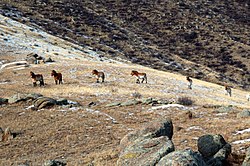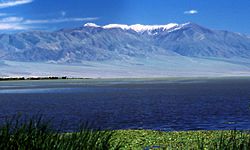| # | Name | Photo | Location | Map | Area (km2) | Year | Description |
|---|---|---|---|---|---|---|---|
| 1 | Altai Tavan Bogd |  | Bayan-Ölgii Province 48°33′N88°37′E / 48.550°N 88.617°E | 6362 | 1996 | Located in the Altai Mountains at the western extreme of Mongolia, the park ("Altai five saints nature complex") includes Tavan Bogd, the highest mountain in Mongolia. Within the park is The (UNESCO) World Heritage Site 'Petroglyphic Complexes of the Mongolian Altai'. [1] [2] | |
| 2 | Gobi Gurvansaikhan |  | SouthGobi Province 43°N104°E / 43°N 104°E | 26947 | 1993 | The park (Gobi three beauties nature complex) is located in the Gurvan Saikhan Mountains, in the Gobi Desert of south central Mongolia. It is the largest national park in Mongolia. Landmarks include Khongoryn Els, the "Singing Sands", a large complex of sand dunes that reach to the southeastern Altai Mountains. [3] | |
| 3 | Gorkhi-Terelj |  | Töv Province 48°09′N107°34′E / 48.150°N 107.567°E | 2932 | 1993 | Gorkhi-Terelj is located 37 km east of the capital city of Ulaanbaatar. Attractions include Khagiin Khar Lake, a 20m deep glacial lake 80 km upstream from the tourist camps, and Yestii Hot Water Springs, natural hot springs 18 km further upstream. The park also has a Buddhist monastery that is open to visitors. [4] | |
| 4 | Khustain Nuruu |  | Töv Province 47°46′N105°53′E / 47.767°N 105.883°E | 506 | 1993 | (Also called "Hustai Nuruu" (Birch Mountains), the park is located about 70 km west of Ulaanbaatar in central Mongolia. It is situated in steppe terrain along the Khentii Mountains, with the Tuul River flowing through its borders. It is part of the UNESCO Man and Biosphere site "Husai Nuruu", and is supporting the reintroduction of the endangered Przewalski's horse. [5] [6] | |
| 5 | Lake Khövsgöl |  | Khövsgöl Province 51°12′N100°50′E / 51.200°N 100.833°E | 8381 | 1992 | The park covers territory surrounding Lake Khovsgul, the largest freshwater lake in Mongolia (over 1,000 square miles and averaging over 450 feet in depth). Located in northwestern Mongolia on the border with Russia, Lake Khovsgul is sometimes referred to as a "younger sister" of Lake Baikal to the north. [7] | |
| 6 | Khyargas Nuur |  | Khovd Province 47°58′N92°50′E / 47.967°N 92.833°E | 8503 | 1997 | Khyargas Nuur is a large (1,481 km2) salt lake in the Great Lakes Basin of western Mongolia, surrounded by desert and scrub. It is half-way between Uvs Lake, 70 km to the north, and Har Us Nuur National Park, 70 km to the south. The lake is known for hot springs. [8] | |
| 7 | Tarvagatai Nuruu |  | Zavkhan Province 48°00′N97°30′E / 48°N 97.5°E | 6576 | 2000 | The park covers the southwestern sector of the Tarvagatai Range of the Khangai Mountains in central Mongolia. The park is remote, protecting a transition zone between semi-arid steppe to the south and coniferous forests on the northern slope of the range. A large fire burned a significant part of the park in 2002, including 800 square kilometres (310 sq mi) of forest. [9] | |
| 8 | Tsambagarav Uul |  | Bayan-Ölgii Province 48°42′N91°00′E / 48.7°N 91°E | 1137 | 2000 | Mt Tsambagarav is a stand-alone mountain of the Mongol Altai Mountains, rising to an elevation of 4,193 metres (13,757 ft). The park features glaciers, rocky gorges, and glacial lakes. [10] | |
| 9 | Bulgan Gol-Ikh Ongog |  | Bayan-Ölgii Province 46°06′N91°10′E / 46.1°N 91.16°E | 927 | 2011 | The Bulgan River divides into many meandering streams, lakes, and wetlands as if flow through the valley in the park. The area is an important stopover for migratory birds. Species in the park include the vulnerable eastern imperial eagle, and the lesser kestrel. [11] [12] | |
| 10 | Chigertein Golin Ai Sav | Bayan-Ölgii Province 47°48′N90°15′E / 47.8°N 90.25°E | 1672 | 2012 | The Chigertey River Valley is a 20-mile wide glacial valley west of Delüünin the Altai Mountains on Mongolia's western border with China. Larch forests grow on the northern slopes of the mountains from elevations of 2,400-2,800 meters. [13] [14] | ||
| 11 | Dariganga |  | Sükhbaatar Province 45°15′N114°00′E / 45.25°N 114.0°E | 645 | 2004 | The park is on the Dariganga Plateau in southeastern Mongolia. Both Gobi desert and steppe habitats are featured around Ganga Lake. The site is a Ramsar Convention wetland of international importance, supporting breeding and migratory waterbirds such as the vulnerable white-naped crane and the vulnerable great bustard. [15] [16] [17] | |
| 12 | Har Us Nuur |  | Khovd Province 48°18′N92°44′E / 48.3°N 92.74°E | 8503 | 1997 | The park is centered on Khar-Us Lake, Khar Lake and Dörgön Lake in the Great Lakes Basin of western Mongolia. [18] [19] | |
| 13 | Ikh Bogd Uul |  | Bayankhongor Province 45°00′N100°18′E / 45°N 100.3°E | 2629 | 2008 | Ikh Bogd ("Great Saint") is the highest mountain in the Altai-Gobi Mountains, a southeastern spur range of the Altai. The middle and high elevations feature alpine meadows and montane steppe. The range, with semi-arid deserts to the north and south, supports rare species, such as the near-threatened argali ( Ovis ammon ) and Pallas's cat ( Otocolobus manul ). [20] [21] | |
| 14 | Khangai Nuruu |  | Arkhangai Province 47°12′N101°24′E / 47.2°N 101.4°E | 8885 | 1996 | The park stretches across the middle ranges of the greater Khangai Mountains in west-central Mongolia. In the northeastern area of the park is the famous Tövkhön Monastery. [22] | |
| 15 | Khan-Khokhi Khyargas Mountain |  | Uvs Province 49°25′N94°47′E / 49.42°N 94.79°E | 3413 | 2000 | The Khan-Khokhi mountains are a western extension of the Khangai Mountains in Uvs Province. The mountains separate the Uvs Depression to the north from the Khyargas Lake depression to the south. The Khan-Khokhii National Park is a separate territory from that of Khyargas Nuur National Park, 20 km to the south. [23] | |
| 16 | Khorgo-Terkhiin Tsagaan Nuur |  | Arkhangai Province 48°12′N99°48′E / 48.2°N 99.8°E | 773 | 1965 | The park is centered on Terkhiin Tsagaan Lake, a freshwater lake in the Khangai Mountains, and the nearby Khorgo volcano (extinct). [24] | |
| 17 | Mongol Els | Zavkhan Province 47°36′N94°42′E / 47.6°N 94.7°E | 2713 | 2010 | This particular "Mongolian Sands" National Park is about 100 km southeast of Khar Lake (Khovd). It covers a sand deposit 300 km long across the Zavkhan River valley. [25] [26] | ||
| 18 | Munkhkhairkhan |  | Bayan-Ölgii Province 47°00′N92°30′E / 47°N 92.5°E | 5061 | 2011 | The park is centered on Mönkhkhairkhan Mountain, the second highest mountain in Mongolia. [27] | |
| 19 | Myangan-Ugalzat | Khovd Province 46°18′N93°12′E / 46.3°N 93.2°E | 3038 | 2011 | The park covers a sector high desert steppe of the Mongol Altai Mountains in western Mongolia. The park was established to protect its populations of the vulnerable Altai argali (Ovis ammon ammon). [28] [29] [30] | ||
| 20 | Noyon Khangai |  | Arkhangai Province 47°45′N99°30′E / 47.75°N 99.50°E | 591 | 1998 | The Noyon Khangai Mountains are a range in the south-central region of the greater Khangai Mountains. There are geothermal hot springs in the area at an altitude of 2,300 metres (7,500 ft). [31] [32] | |
| 21 | Onon-Balj |  | Khentii Province 48°59′N111°06′E / 48.98°N 111.1°E | 4148 | 2000 | Onon-Balj covers the confluence of the Onon River and Balj River in Dadal Soum of Khentii Province. The area features many rivers, lakes, and desert steppe terrain. [33] | |
| 22 | Orkhon Valley |  | Övörkhangai Province 47°27′N102°43′E / 47.45°N 102.72°E | 3530 | 2006 | Valley of the Orkhon River east of the Khangai Mountains, on pastureland, and with many historical and archaeological sites. The site of Kharkhorum, the capital of Genghis Khan's 13th-century empire. A UNESCO World Heritage Site ('Orkhon Valley Cultural Landscape'), and UICN protected area ('Orxoni Xundii'). [34] [35] | |
| 23 | Siilxem Nuruu |  | Bayan-Ölgii Province 49°44′N89°52′E / 49.74°N 89.87°E | 881 | 2000 | Spread across two separate sectors along the border with Russia in the Siilkhem Mountains, northeast of Altai Tavan Bogd. Sector 'A' is the northernmost range of the Altai argali and Sector 'B' is habitat for the snow leopard. [36] [37] | |
| 24 | Tengis-Shishged | Khövsgöl Province 51°29′N98°44′E / 51.49°N 98.73°E | 8757 | 2000 | The park covers the lower Shishged River as if flows west from the Darkhad Valley in northern Mongolia. The landscape is one of high peaks with steep sides and wide glaciated valleys. It protects a cultural region of the Dukha people, nomadic reindeer herders. [38] [39] | ||
| 25 | Tujiin Nars |  | Selenge Province 50°06′N106°24′E / 50.1°N 106.4°E | 708 | 2002 | Tujiin Nars is a pine forest in Selenge Province, in northern Mongolia. An extensive reforestation effort is underway in the park, recovering from forest fires and illegal logging in the 1990s. [40] [41] [42] | |
| 26 | Ulaagchini Khar Nuur |  | Zavkhan Province 48°22′N95°37′E / 48.37°N 95.62°E | 2594 | 2010 | The park encompasses two large freshwater lakes, Bayan Lake to the west, and Ulaagchin Khar Lake 50 km to the east. This is the 'Khar Lake' in Zavkhan Province located in a depression below the Tarvagatai Mountains. Ulaagchin Khar is surrounded by sand dunes and mountains. [43] [44] | |
| 27 | Undurkhaan Uul | Khentii Province 47°30′N110°27′E / 47.5°N 110.45°E | 88 | 2012 | The site is small, covering an isolated mountain surrounded by low areas, about 25 km north of Öndörkhaan. [45] | ||
| 28 | Khugnu-Tarna |  | Bulgan Province 47°28′N103°38′E / 47.47°N 103.64°E | 841 | 2003 | Khogno Khan Mountain is about 60 km east of Kharakoram. The park features many historical sites, including the ruins of a 17th-century monastery. [46] | |
| 29 | Zag Baidragiin Goliin Ekhen Sav | Bayankhongor Province 47°30′N99°28′E / 47.5°N 99.46°E | 1163 | 2012 | The park covers valleys of the Baidrag River and Zag River as they flow south from the Khangai Mountains in west-central Mongolio. [47] | ||
